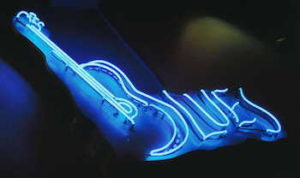
On this date, we will focus on blues music in America. Technically, as a musical style, the Blues are characterized by expressive pitch inflections (blue notes), a three-line textual stanza, and a 12-measure form.
Typically, the first two and a half measures of each line are devoted to singing, and the last measure and a half consists of an instrumental "break" that repeats, answers, or complements the vocal line. African influences have been apparent in the blues tonality from its beginning: the call and response pattern of the repeated refrain, the falsetto break in the vocal style, and the imitation of vocals by instruments, especially the guitar and harmonica.
Although instrumental accompaniment is almost universal in the blues, the blues are essentially vocal. Blues songs are lyrical rather than narrative; the singer expresses his feelings rather than tells a story. The emotion expressed is sadness or melancholy, often due to problems in love. To express this musically, Blues performers use vocal techniques such as syncopation and instrumental techniques such as bending guitar strings on the guitar’s neck or applying a metal slide or bottleneck to the guitar strings to create a whining, voice-like sound.
The beginnings of the Blues are scantily documented. Blues developed in the southern United States after the American Civil War. Work songs and field hollers, minstrel-show music, ragtime, church music, and some folk and popular music of whites influenced it. The blues is derived from and was primarily played by southern Black men who came from the surroundings of agricultural workers—the earliest references to Blues date back to the 1890s and early 1900s. In 1912, Black bandleader W.C. Handy's composition "Memphis Blues" was published. It became very popular, and many other Tin Pan Alley songs entitled “Blues” emerged.
The rural Blues developed mainly in Georgia, the Carolinas, Texas, and Mississippi. The Blues of Georgia and the Carolinas are noted for their clarity of diction and regularity of rhythm. Influenced by ragtime and white folk music, they‘re more melodic than the Texas and Mississippi styles. Blind Willie McTell and Blind Boy Fuller showcased this style.
The Texas blues are set apart by high, clear singing accompanied by supple guitar lines that consist typically of single-string picking rather than strummed chords. Blind Lemon Jefferson was by far the most influential Texas Bluesman. Mississippi Delta Blues are the most intense of the three styles and have had the most impact. Vocally, they are the most speech-like, and the guitar accompaniment is rhythmic and percussive; a slide or bottleneck is often used. The Mississippi style came from Charley Patton, Willie Brown, Eddie "Son" House, Robert Johnson, and Johnny Shines.
Black women such as Mamie Smith, Ma Rainey, Ida Cox, and Bessie Smith made the first blues recordings in the 1920s. These ladies have primarily staged singers backed by jazz bands, singing what is known as “Classic Blues.” The Great Depression and the World Wars caused the geographic dispersal of the Blues as millions of Blacks left the South, heading north, and the Blues adapted to the more sophisticated urban environment. Lyrics took up urban themes, and groups developed as pianists or harmonica players, then a rhythm section consisting of bass and drums joined the solo Blues-man.
The electric guitar and the amplified harmonica created a driving sound of great rhythmic and emotional intensity. The cities where the Blues initially took root were Atlanta, Memphis, and St. Louis. John Lee Hooker settled in Detroit, and on the West Coast, Aaron "T-Bone" Walker developed a style later adopted by Riley "B.B." King. It was Chicago, however, that played the greatest role in the development of urban blues. In the 1920s and 1930s, Memphis Minnie, Tampa Red, Big Bill Broonzy, and John Lee "Sonny Boy" Williamson were popular Chicago performers.
After World War II, they were supplanted by a new generation of Bluesmen, including Muddy Waters, Howlin' Wolf (Chester Arthur Burnett), Elmore James, Little Walter Jacobs, and Otis Spann. The Blues have influenced many other musical styles. Blues and jazz are closely related; seminal jazz musicians such as Jelly Roll Morton and Louis Armstrong employed Blues elements in their music. Soul music, rhythm, and blues also show obvious blue tonalities and forms.
The Blues have had their most significant influence on rock music. Early rock singers such as Elvis Presley often used Blues material. British rock musicians in the 1960s, especially the Rolling Stones, Eric Clapton, and John Mayall were strongly influenced by the Blues, as were such American rock musicians as Mike Bloomfield, Paul Butterfield, Marcia Ball, the Allman Brothers Band, Stevie Ray Vaughn, Kenny Wayne Shepherd, and Jimmie Dale Gilmore and others.
In the 21st century, Keb Mo and others are carrying on the American tradition of the blues.
Nothing But the Blues: The Music and the Musicians
Edited by Lawrence Cohn
Copyright 1993 Abbeville Publishing Group, New York
ISBN 1-55859-271-7
The Blues Fake Book, 400 Songs
Copyright 1999, Hal Leonard Corp.
ISBN 0-7935-5855-7
The Blues Line A Collection of blues lyrics
Compiled by Eric Sackheim and Jonathan Shahn
The Ecco Press, copyright 1969
ISBN 0-88001-328-1